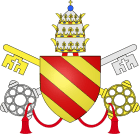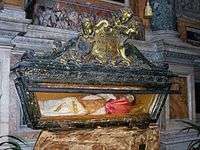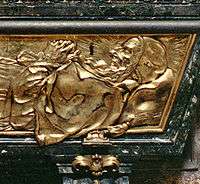Pope Pius V
| Pope Saint Pius V | |
|---|---|
 | |
| Papacy began | 7 January 1566 |
| Papacy ended | 1 May 1572 |
| Predecessor | Pius IV |
| Successor | Gregory XIII |
| Orders | |
| Ordination | 1528 |
| Consecration |
14 September 1556 by Giovanni Michele Saraceni |
| Created Cardinal |
15 March 1557 by Pope Paul IV |
| Personal details | |
| Birth name | Antonio Ghislieri |
| Born |
17 January 1504 Bosco, Duchy of Milan |
| Died |
1 May 1572 (aged 68) Rome, Papal States |
| Previous post |
|
| Motto | Utinam dirigantur viæ meæ ad custodiendas (It binds us to keep)[1] |
| Coat of arms |
|
| Sainthood | |
| Feast day |
|
| Venerated in | Roman Catholic Church |
| Beatified |
1 May 1672 by Pope Clement X |
| Canonized |
22 May 1712 by Pope Clement XI |
| Attributes |
|
| Patronage |
|
| Other popes named Pius | |
Pope Saint Pius V (17 January 1504 – 1 May 1572), born Antonio Ghislieri (from 1518 called Michele Ghislieri, O.P.), was Pope from 8 January 1566 to his death in 1572. He is venerated as a saint of the Roman Catholic Church.[2] He is chiefly notable for his role in the Council of Trent, the Counter-Reformation, and the standardization of the Roman rite within the Latin Church. Pius V declared Thomas Aquinas a Doctor of the Church[3][4] and patronized prominent sacred music composer Giovanni Pierluigi da Palestrina.
As a cardinal, Ghislieri gained a reputation for putting orthodoxy before personalities, prosecuting eight French bishops for heresy. He also stood firm against nepotism, rebuking his predecessor Pope Pius IV to his face when he wanted to make a 13-year-old member of his family a cardinal and subsidize a nephew from the papal treasury.[5]
By means of his papal bull of 1570, Regnans in Excelsis, Pius V excommunicated Elizabeth I of England for heresy and persecution of English Catholics during her reign. He also arranged the formation of the Holy League, an alliance of Catholic states. Although outnumbered, the Holy League famously defeated the Ottoman Empire, which had threatened to overrun Europe, at the Battle of Lepanto. Pius V attributed the victory to the intercession of the Blessed Virgin Mary and instituted the feast of Our Lady of Victory.[6]
Biography
Early life
Antonio Ghislieri was born in Bosco in the Duchy of Milan (now Bosco Marengo in the province of Alessandria,[7] Piedmont), Italy. At the age of fourteen he entered the Dominican Order, taking the name Michele, passing from the monastery of Voghera to that of Vigevano, and thence to Bologna. Ordained priest at Genoa in 1528, he was sent by his order to Pavia, where he lectured for sixteen years. At Parma he advanced thirty propositions in support of the papal chair and against the Protestant Reformation.
As prior of more than one Dominican priory during a time of great moral laxity, he insisted on discipline, and, in accordance with his own wishes, was appointed inquisitor at Como. As his reformist zeal provoked resentment, he was compelled to return to Rome in 1550, where, after having been employed in several inquisitorial missions, he was elected to the commissariat of the Holy Office. Pope Paul IV (1555–59), who, as Cardinal Carafa, had shown him special favor, conferred upon him the bishopric of Sutri and Nepi, the cardinalate with the title of Alessandrino, and the unique honor of the supreme inquisitorship. Under Pope Pius IV (1559–65) he became bishop of Mondovi in Piedmont, but his opposition to that pontiff procured his dismissal from the palace and the abridgment of his authority as inquisitor.[8]
Pontificate
| Papal styles of Pope Pius V | |
|---|---|
 | |
| Reference style | His Holiness |
| Spoken style | Your Holiness |
| Religious style | Holy Father |
| Posthumous style | Saint |
Papal election
Before Michele Ghislieri could return to his episcopate, Pope Pius IV died. On 8 January 1566, Ghislieri was elected to the papal throne as Pope Pius V.[7] He was crowned ten days later, on his 62nd birthday by the protodeacon.
Church discipline
Aware of the necessity of restoring discipline and morality at Rome to ensure success without, he at once proceeded to reduce the cost of the papal court after the manner of the Dominican Order to which he belonged, compel residence among the clergy, regulate inns, and assert the importance of the ceremonial in general and the liturgy of the Mass in particular. In his wider policy, which was characterised throughout by an effective stringency, the maintenance and increase of the efficacy of the Inquisition and the enforcement of the canons and decrees of the Council of Trent had precedence over other considerations.[5] By the time Pius V ascended the throne, Protestantism had conquered all of England and Scotland, as well as half of Germany, the Netherlands, and parts of France; only Spain remained unswervingly Catholic. Pius V was thus determined to prevent its insurgency into Italy--which he believed would come via the Alps and Milan.
Liturgy
Accordingly, in order to implement a decision of that council, he standardised the Holy Mass by promulgating the 1570 edition of the Roman Missal. Pius V made this Missal mandatory throughout the Latin rite of the Catholic Church, except where a Mass liturgy dating from before 1370 AD was in use.[9][10] This form of the Mass remained essentially unchanged for 400 years until Pope Paul VI's revision of the Roman Missal in 1969–70, after which it has become widely known as the Tridentine Mass;[11] use of the last pre-1969 edition of the Missal, that by Pope John XXIII in 1962, is permitted without limitation for private celebration of the Mass and, since July 2007, is allowed also for public use, as laid down in the motu proprio Summorum Pontificum of Pope Benedict XVI. Some continue to use even earlier editions, but without authorisation.
Thomism
Pius V, who had declared Thomas Aquinas the fifth Latin Doctor of the Church in 1567, commissioned the first edition of Aquinas' opera omnia, often called the editio Piana in honor of the Pope. This work was produced in 1570 at the studium generale of the Dominican Order at Santa Maria sopra Minerva, which would be transformed into the College of Saint Thomas in 1577, and again into the Pontifical University of Saint Thomas Aquinas, Angelicum in the 20th century.[12]
Huguenots
Pius V recognized attacks on papal supremacy in the Catholic Church and was desirous of limiting their advancement. In France, where his influence was stronger, he took several measures to oppose the Protestant Huguenots. He directed the dismissal of Cardinal Odet de Coligny[13] and seven bishops, nullified the royal edict tolerating the extramural services of the Reformers, introduced the Roman catechism, restored papal discipline, and strenuously opposed all compromise with the Huguenot nobility. The papal forces sent to aid France in quelling Huguenot resistance had orders to take no prisoners.
Character and policy

As a young man, Michele Ghislieri was eager to join the inquisition. Under Paul IV (the most hated pope of the 16th century)[14] he rose to inquisitor general, and from there ascended to the papacy. Unlike some popes, he gained neither compassion nor piety from his new position, which only seemed to add to his inquisitorial zealotry. As Pius V, he personally attended all sessions of the Roman inquisition. Afterwards he often stayed to watch, unmoved, as supposed lawbreakers and heretics were tortured.[14] As an inquisitor he had been fiercely determined to root out homosexuality in monasteries; as Pius V he made all sexuality his target, and passed a number of laws which appeared even to his contemporaries to be cruel, ridiculous, and (occasionally) bizarre. Women were suddenly banned from viewing the Vatican sculpture collections. In the Sistine Chapel, hack painters smeared Michelangelo's nudes with loincloths. All unmarried prostitutes were to be whipped; all sodomites burned at the stake. Unmarried men could not employ female servants and--inexplicably--nuns could not keep male dogs.[14] Adultery came close to being ruled a capital offense. Even in nonsexual matters, Pius was determined to force piety upon his subjects. Doctors were forbidden to treat patients who had not recently confessed or received the sacraments. Blasphemers were treated according to their pocketbooks. The rich were heavily fined, the poor were flogged. These draconian laws quickly made Pius V the subject of Roman hatred; he was accused (not unjustly) of trying to turn the city into a vast monastery. It should be noted, however, that he was not a hypocrite: in day-to-day life Pius V was highly ascetic. He wore a hair shirt beneath the simple robes of a Dominican friar and was often seen in bare feet. [14]
In the list of bulls he issued are many which shed light on his character and goals, the famous "In Coena Domini" (1568) takes a leading place, but there are several others of note, including his prohibition of quaestuary (February 1567 and January 1570); condemnation of Michael Baius, the heretical Professor of Leuven (1567); reform of the Roman Breviary (July 1568); formal condemnation of homosexual behaviour by the clergy;[15] (August 1568); the banishment of the Jews from all ecclesiastical dominions except Rome and Ancona (1569);[16] an injunction against use of the reformed missal (July 1570); the confirmation of the privileges of the Society of Crusaders for the protection of the Inquisition (October 1570); the suppression of the Fratres Humiliati (February 1571); the approbation of the new office of the Blessed Virgin (March 1571); the enforcement of the daily recitation of the Canonical Hours (September 1571); and the purchase of assistance against the Turks by offers of plenary pardon (March 1572).
Katherine Rinne writes in Waters of Rome[17] that Pius V ordered the construction of public works to improve the water supply and sewer system of the city--a welcome step, particularly in low-lying areas, where typhoid and malaria were inevitable summer visitors.
Elizabeth I
His response to the Queen Elizabeth I of England assuming governance of the Church of England included support of the imprisoned Mary, Queen of Scots and her supporters in their attempts to take over England "ex turpissima muliebris libidinis servitute" "from a most sordid slavery to a woman's voracity". A brief English Catholic uprising, the Rising of the North, had just failed. Pius then issued a bull, Regnans in Excelsis, dated 27 April 1570, that declared Elizabeth I a heretic and released her subjects from their allegiance to her.[18] In response, Elizabeth, who had thus far tolerated Catholic worship in private, now actively started persecuting them for treason.
Holy League
Saint Pius V arranged the forming of the Holy League against the Islamic Turks, as the result of which the Battle of Lepanto (7 October 1571) was won by the combined fleet under Don John of Austria. It is attested in his canonisation that he miraculously knew when the battle was over, himself being in Rome at the time.[19] Three national synods were held during his pontificate at Naples under Alfonso Cardinal Caraffa (whose family had, after inquiry, been reinstated by Pius V), at Milan under Saint Charles Borromeo, and at Machim.
Papal garments

Pius V is often credited with the origin of the Pope's white garments, supposedly because after his election Pius continued to wear his white Dominican habit. However, many of his predecessors also wore white with a red mozzetta, as can be seen on many paintings where neither they nor Pius is wearing a cassock, but thin, wide, white garments.
An article by Agostino Paravicini Bagliani on L'Osservatore Romano of 31 August 2013 states that the earliest document that speaks explicitly of the Pope wearing white is the Ordo XIII, a book of ceremonies compiled in about 1274 under Pope Gregory X. From that date on, the books of ceremonies speak ever more explicitly of the Pope as wearing a red mantle, mozzetta, camauro and shoes, and a white cassock and stockings.[20][21]
Death and canonisation
| Pope Saint Pius V | |
|---|---|
 Pius V depicted in an early printed missal | |
| Pope, Confessor | |
| Born |
17 January 1504 Bosco Marengo, Italy |
| Died |
1 May 1572 Rome, Italy |
| Venerated in | Roman Catholic Church |
| Beatified | 1672 by Pope Clement X |
| Canonized | 22 May 1712 by Pope Clement XI |
| Feast | 30 April |
| Patronage |
|

Pius V died on 1 May 1572 of what is believed to be cancer. He was buried in the chapel of S. Andrea which was close to the tomb of Pope Pius III, in the Vatican. Despite that his will requested he be buried in Bosco, Pope Sixtus V built a monument in the chapel of SS. Sacramento in the Liberian basilica. His remains were transferred there on 9 January 1588.
In 1696, the process of Pius V's canonisation was started through the efforts of the Master of the Order of Preachers, Antonin Cloche. He also immediately commissioned a representative tomb from the sculptor Pierre Le Gros the Younger to be erected in the Sistine Chapel of the Basilica di Santa Maria Maggiore. The pope's body was placed in it in 1698. Pope Pius V was beatified by Pope Clement X in the year 1672,[22] and was later canonized by Pope Clement XI (1700–21) on 22 May 1712.[23][24]
In the following year, 1713, his feast day was inserted in the General Roman Calendar, for celebration on 5 May, with the rank of "Double", the equivalent of "Third-Class Feast" in the General Roman Calendar of 1960, and of its present rank of "Memorial".[25] In 1969 the celebration was moved to 30 April, the day before the anniversary of his death (1 May).
Historian John Julius Norwich calls his canonization "unaccountable."[14]

The front of his tomb has a lid of gilded bronze which shows a likeness of the dead pope. Most of the time this is left open to allow the veneration of the saint's remains.
Pius V also helped financially in the construction of Valletta, Malta's capital city, by sending his military engineer Francesco Laparelli to design the fortification walls.
See also
References
- ↑ "Pope Pius V (1566-1572)". GCatholic. Retrieved 15 April 2014.
- ↑ Durant, William ‘Will’; Durant, Ethel ‘Ariel’ (1961), Age of Reason Begins, The Story of Civilisation 7, Simon & Schuster, pp. 238–39
- ↑ Thomas Aquinas (1911). "The "Summa Theologica" of St. Thomas Aquinas" 1. New York.
- ↑ Jan Peil; Irene van Staveren, eds. (2009-01-01). Handbook of Economics and Ethics. Northampton, Massachusetts and Cheltenham, United Kingdom: Edward Elgar Publishing. p. 8. ISBN 978-1-84542-936-2.
- 1 2 "Pope St. Pius V". New York: Robert Appleton Company. Retrieved 7 July 2014.
- ↑ Aimé Georges Martimort (ed.). The Church at Prayer: The Liturgy and Time 4. p. 145. ISBN 0-8146-1366-7.
- 1 2 Fernand Braudel (1995). The Mediterranean and the Mediterranean World in the Age of Philip II 2. University of California Press. p. 1027. ISBN 0-520-20330-5.
- ↑ Alban Butler and Paul Burns (1999). Butler's Lives of the Saints: April. Liturgical Press. p. 220. ISBN 0-8146-2380-8.
- ↑ Daniel Keyte Sandford; Allan Cunningham Thomas Thompson (1841). The Popular Encyclopedia. p. 842.
- ↑ Don S. Armentrout; Robert Boak Slocum, eds. (2000-01-01). An Episcopal Dictionary of the Church: A User-Friendly Reference for Episcopalians. ISBN 9780898697018.
- ↑ Russell B. Shaw (1998). Our Sunday Visitor's Catholic Encyclopedia. p. 872. ISBN 0-87973-669-0.
- ↑ Renzi, Christopher J (2009), In This Light Which Gives Light: A History of the College of St. Albert the Great, p. 42, ISBN 9781883734183, retrieved 24 April 2011
- ↑ Joseph Mendham (1832). "The life and pontificate of Saint Pius V" 37. London: 54.
- 1 2 3 4 5 Norwich, John Julius (2011). Absolute Monarchs. New York: Random House. pp. 319–20. ISBN 978-1-4000-6715-2.
- ↑ "Pio V – Antonio Michele Ghislieri (1504–1572)", Cronologia [Chronology] (in Italian), IT: Leonardo,
...la denuncia del dirum nefas, "l'esecrabile vizio libidinoso"..
- ↑ Krinsky, Carol Herselle. 1996. Synagogues of Europe: Architecture, History, Meaning. Courier Dover Publications. ISBN 0-486-29078-6. p. 118.
- ↑ Rinne, Katherine (January 2001). Waters of Rome. Yale University Press. ISBN 0-300-15530-1.
- ↑ Ehler, Sidney Z., Church and State Through the Centuries, (Biblo-Moser, 1988), 180.
- ↑ "The Story of Don John of Austria". Nobility.org. 11 October 2010. Retrieved 23 June 2013.
- ↑ "Vatican newspaper examines history of red, white papal garb". Catholic culture. 2 September 2013.
...the first document that mentions the Pope's white cassock dates from 1274.
- ↑ "From red to white", L'Osservatore Romano (VA)
- ↑ Richard P. McBrien (2006). The Pocket Guide to the Popes. Harper Collins. p. 283. ISBN 0-06-113773-1.
- ↑ "Pope Pius V". Catholic Hierarchy. 29 Sep 2013. Retrieved 26 Feb 2014.
- ↑ Corkery, James; Worcester, Thomas (2010). The Papacy Since 1500: From Italian Prince to Universal Pastor. Cambridge University Press. pp. 56–57. ISBN 978-0-521-50987-9.
- ↑ General Roman Calendar.
Further reading
- St Pius V, by Robin Anderson, TAN Books and Publishers, Inc, 1973/78. ISBN 0-89555-354-6
External links
| Latin Wikisource has original text related to this article: |
| Wikimedia Commons has media related to Pius V. |
- "Pope St. Pius V", Catholic Encyclopedia, New Advent.
| Catholic Church titles | ||
|---|---|---|
| Preceded by Pius IV |
Pope 7 January 1566 – 1 May 1572 |
Succeeded by Gregory XIII |
| |||||||||||||||||||||||||||||||||||||||||||||||||||||||||||||||||||
|

